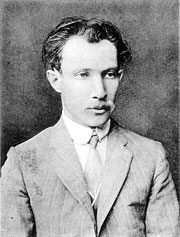Uri Nissan Gnessin
Uri Nissan Gnessin (born October 29, 1879 in Starodub , Russian Empire , † March 6, 1913 in Warsaw , Russian Empire) was a Russian, Hebrew writer.
Life
Gnessin spent his childhood and youth in Pochep in what is now Bryansk Oblast , receiving lessons first in a cheder and later in a yeshiva , the director of which was his father. Here he made friends with Josef Chaim Brenner . In addition to his religious studies, Gnessin was also interested in secular subjects and learned classical and modern languages and literatures. He was already writing poetry as a child and, at the age of 15, began working with Brenner to publish a monthly literary magazine and a weekly magazine for a small group of friends. Nachum Sokolow invited the 18-year-old writer to become an editorial assistant for the newspaper HaTzefira (“The Alarm”) in Warsaw. Here Gnessin was able to publish poems, reviews, short stories and translations. In 1904 a small collection of stories was published under the title Zilelei ha-Chaim ("Shadow of Life"), but they do not yet have an individual character. At this time Gnessin began an erratic journey.

After a year in Warsaw, he moved to Yekaterinoslav , then to Vilnius and Kiev . In 1907 he traveled to London at the invitation of Brenners, where the two of them together published the magazine Ha-Meorer ("Der Wecker"). The failure of this company led to heated arguments between Brenner and Gnessin. In the autumn of 1907 Gnessin wanted to emigrate to Erez Israel , but this experience was also a disappointment for him. Gnessin returned to Russia in the summer of 1908 and died of a heart attack in Warsaw four years later. He was buried in the Jewish cemetery on Okopowa Street .
plant
The peculiarity of Gnessin is that he was the first to introduce certain literary techniques into Hebrew literature. With the help of the inner monologue , he expresses the fearful states of his literary characters. As one of the first Hebrew writers, he deals with the issues of alienation and uprooting, especially their influence on Jews of the modern age. In four narratives: Hazidda (“Beiseite”, 1905), Benatajim (“Meanwhile”, 1906), Be-terem (“Before”, 1909) and Ezel (“Bei”, 1913), whose names alone indicate the lack of reference to the protagonist to express space and time, Gnessin describes a man who leaves his native shtetl , travels to distant lands and becomes a citizen of the world , only to find himself finally uprooted. Upon his return, he is faced with the frightening fact that he has become a stranger in his own homeland. The past cannot be brought back, the rift to the present becomes insurmountable, and he finds himself in a strange, confusing world. These stories are influenced by Ibsen , Strindberg and the stories of Anton Chekhov . Using associative technology , Gnessin blurs the boundaries between past, present and future. He signed his critical treatises with U. Esthersohn. He translated prose poems by Baudelaire into Hebrew as well as works by Chekhov, Heinrich Heine , Sigbjørn Obstfelder and by Jakob Wassermann the novella Die Juden von Zirndorf , a chronicle from the 17th century about the life of Shabbetaj Zvi .
literature
- Encyclopedia Judaica . Volume 7, pp. 634-636.
- Maria Kühn-Ludewig: Yiddish books from Berlin (1918-1936): titles, people, publishers. Kirsch, Nümbrecht 2008, ISBN 978-3-933586-56-8 .
- Sorrel Kerbel: The Routledge Encyclopedia of Jewish Writers of the Twentieth Century. Taylor & Francis Group, 2003, ISBN 1-57958-313-X , p. 352.
Web links
| personal data | |
|---|---|
| SURNAME | Gnessin, Uri Nissan |
| BRIEF DESCRIPTION | Hebrew writer |
| DATE OF BIRTH | October 29, 1879 |
| PLACE OF BIRTH | Starodub |
| DATE OF DEATH | March 6, 1913 |
| Place of death | Warsaw |
